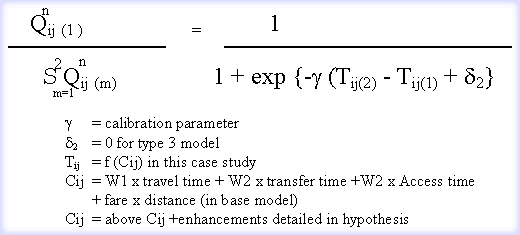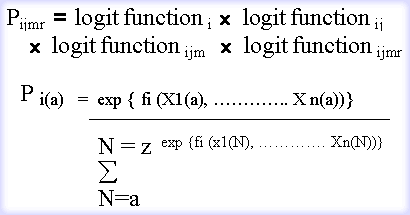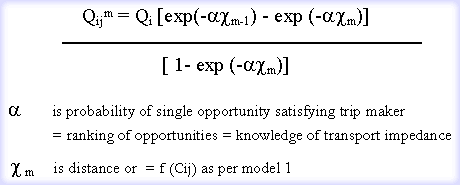Introduction
Methodology of Research
Previous months progress
Model Specifications
Introduction
In progressing through this research, a number of needs were drawn out from my review of literature over the space of 40 years of commentary and thinking on the subject of accessibility. In the process, it was observed that today�s context for models is one where they are considered in an overarching process along side vision, objectives, quality of life and less quantifiable environmental considerations. I have highlighted the shift in modelling emphasis that has taken place with the shift towards inclusion of modelling types other than 4 stage TPM�s.
At my July 2002 seminar I presented , my �hunch� that one of the most important needs is for better representation of transport supply in the modelling process and proceeded to outline a hypothesis for testing and a program for case study development. Comment at the seminar pointed out that my establishment of need and clarity of the research was still needing further work.
Over the following semester, examination was made of the previous and current commentaries from this perspective, to see if it was possible to provide clearer evidence of this �hunch�. The findings are restated here as they are central to the development of the hunch into a hypothesis with a sound methodology for case study analysis.
Bannister in his commentary pointed out that along with a shift in social priorities in the 1980�s has come an increase in complexity in the process involved in urban living. He observed that this has come about through industrial restructuring, advances in communications and increasing interaction between modes of transport. This trend has continued through to the present day. Further complexity lies ahead over the next half century, with the expected change in demographics at the workforce as a large portion of the current workforce moves into retirement.
Increasing supply complexity, including concern for environmental fit and desire for good use of resources has led to transport system configurations delivered today that are planned well ahead of commitment to funding. The match between users� requirements and the system is therefore really a question of match between users� requirements and the �modelled� transport system characteristics and the process of translating this into the operational system. It is fair to deduct that with these increasing process complexities that the real transport system�s effectiveness is greater, the better the match between users� perceived requirements and the modelled system. This suggests the need for greater specification of sensitive characteristics in the transport system being modelled.
My review on accessibility has shown that historically two general types of quantifiable models have developed. The traditional Transport Planning Models (TPM) or 4 step process model, (with its limitations in relationship to landuse) and the Integrated Land Use Transport Models (ILUTM) (with its inclusion of landuse/transport interaction). The most prominent ILUTM type model are the spatial interaction models with their affiliation with TPM and the Lowry model (1964).
The full range of TPM transport planning modelling and ILUTM modelling approaches in common use since the 1950�s have been examined.
The four steps of the classical TPM are Trip Generation, Trip Distribution, Modal Split and Trip Assignment to routes, usually in this sequential order. The common use of distance, time or generalised cost to characterise the representation of transport supply is largely a simplistic characterisations of the transport system.
Allied applications of behavioural models focussing on individual choice, representing the trip makers importance of a greater variety of attributes, have typically included a greater complexity of transport system attributes. Until recently though, they have been used for only some of the demand steps. The most detailed relationship of demand to transport supply is found in the attributes of the behavioural modelling applied to mode choice in logit models.
Aggregate TPM�s are noted for their insensitivity to transport changes due to the trip generation stage and lack of interactivity between the sequential stages of the modelling. Critical comment was observed by a number of researches on the sequential nature of the TPM and lack of feedback. A number of approaches are available for improving this, such as integration of trip distribution and modal choice models or the inclusion of feedback links at the stages between trip distribution and trip assignment. A possibility is to add an iterative process inclusive of better representation of transport characteristics.
The recent development of complete TPM equivalents such as Transims, Stockholm and Oppenheim�s models which have greater interactivity between stages and possibility to better include attributes is evidence of the need to explore better representation of transport attributes and process interactions.
The TPM is traditionally land use exogenous, that is land use is determined elsewhere and fed into the transport planning model. The integrated land use and transport model is characterised by an interaction between transport and landuse. There are degrees of interaction and as noted by recent researchers, there is a greater landuse to transport interaction than the reverse.
ILUTM models share the outputs of TPM modelling whether exogenously or whether partly or fully integrated. Usually it is an aggregate form of the TPM, with its inherent sequential structure. TPM modelling has developed a greater experience with behavioural modelling techniques, though some of this is now overlapping into ILUTM. Accessibility provides bridging between transport and landuse location, economic and societal considerations. As such it is a feature in urban ILUTM and Productivity assessments at a regional level. Historically accessibility has not developed a strong presence in TPM.
Both TPM and ILUTM models have a common transport supply characterisation in the transport impedance function which is either represented as travel time, distance or generalised cost. This is an explanatory variable on the demand side of both types of model and on the supply side in the trip assignment process to destination mode and route. This same function is also a characteristic of the accessibility measure so important to ILUTM. The most detailed characterisation of transport supply in ILUTM models, is in the generalised cost formulation. However in practice its specification has remained quite simplistic.
Generalised cost has been seen to be defined as including travel time, cost and convenience of travel. However, there is little evidence of the convenience component being put into practice in the models.
Behavioual modelling demonstrated in TPM�s have been seen to be of either utility, attitudinal or activity based rationale�s. The depth of explanatory variables characterising transport supply attributes is impressive. However, its linkage to all parts of the modelling process is evidenced as still in a developmental stage.
Inclusion of accessibility, improvements in interactivity of the decision steps modelled and better representation of attributes of importance to individual trip makers are key research focuses seen in the discussion. The case is clear for improvements to transport supply representation. The attributes of the logit modelling, the stochastic component and the generalised cost function of the classic approach provide three focal points for this research.
Methodology of Research
Aim:
It has been observed that the representation of transport system characteristics in the full spectrum of TPM and ILUTM models is simplistic. Behavioural models in use provide a range of system attributes the trip maker can consider as important, e.g personal comfort, personal safety. Generalised cost is observed to include weighted linear combinations of time and out of pocket costs and the concept of a convenience parameter.
Scope exists for developing further, the modelling specification of transport systems in terms that are relatable to the attributes of importance to trip makers decisions on trips and the choice of residence. With increasing diversity of modal integration and transport technology, a contribution to increasing transport modelling sensitivity to transport system innovation, is considered a worthy goal for research. If it can contribute to a more realistic representation of transport system performance, decisions have a greater opportunity to be good choices.
This research is aimed at testing modifications to the generalised cost representation on a cross section of models in use today. It is proposed to case study an area where a large change has been occurring in trips across census years. The Sydney urban areas in the mid to fringe zones have been observed by a number of researchers to display large increases in VKT in the JTW data sets and provides a suitable case study for this research.
Hypothesis:Modifying the user utility and generalised cost representation of the transport system characteristics, by :
- inclusion of system performance characteristics with a traceable relationship to user�s perceived system requirements.
- integration with accessibility measures
enhances modelling responsiveness to changes in system performance and hence improves the level of explanatory outcomes in trips and urban sustainability.
Research Design:A selected number of models representative of TPM and ILUTM are selected for testing with the protype improvements against control models without improvements.
Detail of the case study design is illustrated in the following flowchart. The image is quite large, so you can choose to view all at once, or one half at a time.

View full image |


View image in halves |
Previous months progress:
- Determined how to obtain and in process of gathering 1991 and 2001 journey to work data sets. Already have 1996 data sets.
- Presently gathering data suitable for calibration of models. Analysing data obtained from recent studies throughout the 1990�s ( i.e. revealed and stated preference survey data , values of time and various elasticities.)
- Studying the limitations of modelling using SLA�s . Choosing SLA�s with required changes in VKT .Ability to be representative of the population distribution within SLA. Selecting technique of allocating stratified population numbers to cells within SLA.
- Exploring the source of public transport and road networks for the models in 1991 and 1996.
- Examining how to include trips to employment zones across the Sydney area. Trips to external SLA�s, trips to SLA�s which are also in the set of study SLA�s and trips within an SLA.
- Inclusion of relocation of employment between 1991 and 1996 as a virtual change in network characteristic for stratified populations which are suited to work in that type of employment.
Model Specifications:
1. Four Step TPM(Type3): Double Constrained with exponential deterrance model:
- stratified aggregate data to limit the averaging effect of aggregate data. Stratified by age, sex and industry.
- doubly constrained
- G, D+M, A model sequence, with feedback between A and D+M
- combined exponential & power function:

- Distribution and mode split structure of model assumes two modes:

2. Oppenheim Nested Uncongested Logit model:
- G,D,M,A simultaneous model sequence
- Using utility based preference functions
U 1(a) = fi (X1(a),X2(a),X3(a),......Xn(a))
Where X1(a) to X2(a) are the attributes forming the explanatory variables.
- Model Structure

3. Intervening opportunities Model:
- G,D+M,A model sequence
- Model structure

4. Proposed Model improvements:
- add transport system attributes
eg:
- Convenience, personal safety, comfort and reliability lead to generalised cost.
- Accessibility leads to generalised cost

- trial inclusion of modifications above at selected steps in the test models i.e G, D, M, A
5. Data Sources & Modelling resources:
| Historical Trip Data |
Attributes of Historical Network Changes |
Attributes of Innovative Future Network Changes |
Transport Modelling Platforms |
Spatial database of network and transport zones |
| JTW to 96: Civ Eng & Built Env |
RTA on road changes |
High Speed Mode: Transrapid |
TransCad: Civ Eng or Built Env |
Built Env matrices |
| JTW 1991 & 2001: to be acquired DOT |
State Rail on Rail changes |
Medium Speed Mode: City Rail & DOT |
. |
. |
| . |
Local Gov on local access changes |
Lower Speed Mode: Alltrans |
. |
. |
|